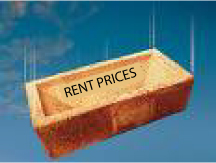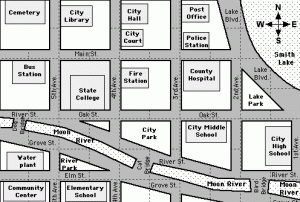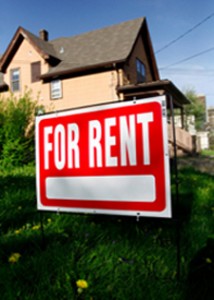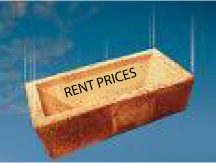Posted by Teresa on July 23, 2010 under Housing Trends, Landlord Tips | 
 Regardless of the economy or the rental market, it is always a good time to retain your tenants. To keep tenants from moving out, some landlords have been offering incentives like free cable and even large-screen TVs to go with them. But is it really worth it to invest that kind of cash into keeping tenants?
Regardless of the economy or the rental market, it is always a good time to retain your tenants. To keep tenants from moving out, some landlords have been offering incentives like free cable and even large-screen TVs to go with them. But is it really worth it to invest that kind of cash into keeping tenants?
Actually, yes. Savvy rental property owners know that keeping tenants is a good idea. Here are three reasons why you should retain tenants when possible:
1. Empty units cost money. Whether or not a rental unit is producing income, it is costing you money.. Mortgage payments, taxes, maintenance, lawn service, and sometimes even utilities continue to chip away at your cash reserves, while It could take one, three, four months or longer to find an acceptable new tenant. Why not do what you need to do to keep a current tenant in place?
2. Turnover is costly. There are a number of expenses associated with turning over a rental unit to a new tenant:
- Advertising
- Management fees for finding a new tenant
- Installing new carpeting, flooring, or paint
- Repairs
- Damage each time furniture is moved in and out
- Lost rental income during the changeover
- Tenant screening
Landlords are better off delaying these expenses as long as possible. You don’t want to incur these costs before you absolutely must. And don’t forget—the time needed to complete the changeover to a new tenant is lost rental income, too.
3. Reduced rents: It’s all about perception. A full building looks like a good place to be, and frequent tenant turnover looks bad. If your tenants are regularly moving out of your rental units, it can affect the rent you can charge. Think about the impact on potential new tenants if, each time they do a drive-by look at your apartment building or 4-plex, there is a moving van out front—and it’s not being unloaded. Potential future tenants will get the impression that nobody wants to live there, and the value of your rental will decline. Stability means desirability, which means higher rent.
Whether it means giving lease-renewing tenants a DVD player, a restaurant gift card, or free cable upgrades, it is usually worthwhile to invest a little to keep a tenant happy and in place.
Posted by Teresa on July 12, 2010 under Housing Trends, Landlord Tips | 
 When it comes to advertising a rental property, most landlords are sure to include the basics: the number of bedrooms and bathrooms, any included appliances, and of course, the area of town or neighborhood it’s in.
When it comes to advertising a rental property, most landlords are sure to include the basics: the number of bedrooms and bathrooms, any included appliances, and of course, the area of town or neighborhood it’s in.
But you might be surprised to hear that potential tenants also want to know about an area’s walkability rating. What’s that? Walkability is a way to determine how close a property is to shops, grocery stores, libraries, and other amenities that people want. If you can get there by leaving the car in the garage, it’s walkable—and the more amenities within walking distance, the higher a property’s walkability rating.
Walkability means that tenants can avoid the congestion, parking, and pollution associated with driving—and still get their errands run. Walkability makes a neighborhood more pleasant to live in—and studies show that more amenities within walking distance can boost home values. Given that tenants want walkable residences, you might want to advertise the walkability rating for all your rental properties.
How do you know if your vacant rental is in a walkable neighborhood? It’s quick and easy on WalkScore.com, a popular site that measures how many amenities are within walking distance of any address. While the site’s algorithm gives the actual distance from an address to stores, restaurants, movie theaters and public transportation, it doesn’t factor in safety, street design or topography. So, it won’t mention any huge hills you’d have to climb to reach the nearest bookstore.
While WalkScore.com will likely add improvements like topography and presence of sidewalks, it’s still a clear snapshot of the amenities surrounding your rental property. Whether or not you include a walkability rating in your rental ads, consider using this tool to inform potential tenants of all the great stores, restaurants, and coffee shops that are close to your rental units.
Posted by Teresa on April 23, 2010 under Housing Trends, Landlord and Tenant FAQs | 
 Are pets welcome in your rental properties? If so, you may have noticed more tenant applicants who are moving their pets along with their kids and furniture. Pet ownership is up in the United States—and so is the percentage of rental units that are pet-friendly.
Are pets welcome in your rental properties? If so, you may have noticed more tenant applicants who are moving their pets along with their kids and furniture. Pet ownership is up in the United States—and so is the percentage of rental units that are pet-friendly.
But one reason for more pet-owning rental applicants may be the increase in foreclosures in the US. A typical track for pet owners is to get that first dog or cat when they buy their first home. But what about after they lose their job and their home—and must return to a rental lifestyle? Many are finding their pets are not welcome at rental units that otherwise work—and often, these socialized, housebroken family pets are being abandoned in shelters.
The rental market is difficult enough right now—why not remove one barrier to filling those vacant homes and apartments that are not making you any money? If you are a landlord who doesn’t accept pets, why not reconsider that policy? Studies show that allowing pets helps fill vacancies—so it’s good for business. And if you create a solid rental pet policy, you may find that the reasons you weren’t accepting pets (noise, damages, liability) were not valid after all.
Besides, it’s bad enough for a family to lose their home, for kids to move away from their neighborhood friends, and possibly switch to a new school. But it’s even worse when the comfort and companionship of a beloved pet is taken away, as well. Pet owners who are allowed to bring these family members along to a new rental are often so grateful, they are more than willing to agree to even the strictest of pet policies.
We’ve written about pet policies before. Check out the basics, and consider allowing pets in your rentals. You might find that with a large enough pet deposit to cover possible damage, plus clear rules and appropriate consequences established up front, pets in your rental properties can work for everyone!
Posted by Teresa on April 10, 2010 under Housing Trends, Landlord and Tenant FAQs, Landlord Tips | 
 In 2007, the U.S. Census Bureau reported 62% of U.S. households used the Internet in their home. That’s an enormous increase from 18% in 1997, the first year Internet use was tracked. 82% of those users reported having high-speed access, and 17% reported use of a dial-up connection. By October, 2009, some reports stated that Internet-using households in the U.S. increased to 69%.
In 2007, the U.S. Census Bureau reported 62% of U.S. households used the Internet in their home. That’s an enormous increase from 18% in 1997, the first year Internet use was tracked. 82% of those users reported having high-speed access, and 17% reported use of a dial-up connection. By October, 2009, some reports stated that Internet-using households in the U.S. increased to 69%.
It’s clear that the majority of American households use the Internet. And, the majority of those users have high-speed access. Demand has been overwhelmingly established. The only question is who pays for it?
Free Internet service is a common tenant perk. In some areas, it’s a given that a rental condo or apartment will come with free Internet—even though it might be bundled into the rent. In other markets, tenants are expected to pay for all of their utilities themselves—including Internet service.
And even though the first quarter apartment rent report showed promising results in some markets, things are still tough in the rental property business. Plenty of competition means owners continue to create incentives to attract good tenants. Is providing Internet service a good move?
Look at your market. Survey Craigslist.org and other online listing services for rental housing offers in your category. If the majority of single-family rentals do not brag about free Internet, you might need to provide it in yours. But, if you own an apartment building near your local college campus, and everyone else in the For Rent category is offering free Internet, you might have just found the reason your rentals are not filling up fast enough.
Check with your local Internet service provider about the cost of wireless service. Modem leases and monthly charges vary. Ask about security, too—especially if you have a duplex or multi-family housing situation. You don’t want a situation where tenants are vulnerable to stolen information—and you don’t want to provide free Internet to the entire neighborhood! Your ISP should be able to set up a secure system for your rental units quickly.
Whether you pass the cost along to your tenants or not probably depends on the cost, right? Still, hearing “free Internet” might be the tipping point that makes a potential tenant a year-long lease-signing tenant. And if you’re in need of some more of those, you might want to at least consider providing free Internet.
Posted by Teresa on March 17, 2010 under Housing Trends | 
The National Association of Home Builders recently released its Multifamily Housing Market Index for the 4th Quarter 2009. The Index shows a dampening of enthusiasm among those polled, to say the least.
At the time the data was complied, rental housing vacancies were expected to continue increasing, as was supply. Asking rent dropped from the 3rd quarter, but effective rents rose slightly over the same period.
Another troubling figure from the report is Percent of New Apartments Rented within 90 days, which dropped from 45.8 in the 3rd quarter to 34.1 in the 4th.
However, a positive note is seen in the increase in volume of calls from prospective renters. That figure was 8 points higher than in Q3 2009 and 6 points higher than Q2 2009.
What does all this mean for rental property owners and managers? Well, if you are sitting on brand new apartments, you will likely need to work harder than before to get them rented. But that doesn’t mean your phone isn’t ringing at all—in fact, the index shows a healthy increase in Prospective Renter call volume.
Perhaps more amenities, rent concessions, or lower rent will continue to be required to fill these vacant properties. Are callers finding a better deal in single-family rentals? Are they staying home with mom and dad rather than move into their own apartment? Or do renters continue to double- and triple-up with their friends, waiting to see what happens with rents?
Whatever is going on in renters’ minds, the message is clear: the multifamily rental market is expected to stay soft—and painful for those who are in it—at least for the foreseeable future. Stay tuned for more fascinating facts and figures as they are reported!
Posted by Teresa on January 7, 2010 under Housing Trends, Rental Market | 
Reis, Inc., a real estate research firm just released its 4th Quarter 2009 apartment vacancy report. As expected, it hit 8%—the highest in thirty years. The poor state of the U.S. job market continues to be blamed, as job creation lags behind other positive economic indicators. Young people, who are typically apartment renters, have been hit especially hard in the job market.
A bit more positive is the news that an ever-increasing supply of newly built apartment units is starting to decline—finally catching up with the credit crunch that began in the summer of 2008. 28,000 new apartments came onto the market in the 4th quarter 2009. The total for the year: 120,000, including developments intended for condos that converted to rentals. New apartment supply should fall by half in 2011, and if jobs improve, there could be some rental market recovery by the middle of this year, according to the report.
The U.S. apartment vacancy rate rose .10 percent from the 3rd quarter, and 1.3 percent for the year, ending at 8%. Sunbelt cities like Tucson AZ, and Jacksonville, FL experienced huge vacancy increases in 2009, at 10.5% and 14.4%, respectively. Charlotte, NC and Lexington, KY were also hit hard. Nationwide, vacancies increased in 52 markets, improved in 17, and remained flat in 10.
Not only are vacancies higher than ever, but landlords are experiencing a double-whammy: both asking and effective rents are plummeting. For 2009, asking rents fell 2.3%, also the largest decrease in thirty years; effective rent fell .7% to $964 per square foot.
And while mortgage financing has toughened up, government efforts to enhance the housing market threaten apartment owners, as some renters find it easier to buy a home. In some markets, continued unrest in the housing sector and lower rents will make renting more attractive than buying.
Landlords and rental property owners will likely need to continue offering rent reductions, perks and amenities to entice new tenants—until the job market improves. And when that will happen is anybody’s guess.
 Reis, Inc., a real estate research firm just released its 4th Quarter 2009 apartment vacancy report. As expected, vacancies hit 8%—the highest in thirty years. The poor state of the U.S. job market continues to be blamed, as job creation lags behind other positive economic indicators. Young people, who are typically apartment renters, have been hit especially hard in the job market.
Reis, Inc., a real estate research firm just released its 4th Quarter 2009 apartment vacancy report. As expected, vacancies hit 8%—the highest in thirty years. The poor state of the U.S. job market continues to be blamed, as job creation lags behind other positive economic indicators. Young people, who are typically apartment renters, have been hit especially hard in the job market.
A bit more positive is the news that an ever-increasing supply of newly built apartment units is starting to decline—finally catching up with the credit crunch that began in the summer of 2008. 28,000 new apartments came onto the market in the 4th quarter 2009. The total for the year: 120,000, including developments intended for condos that converted to rentals. New apartment supply should fall by half in 2011, and if jobs improve, there could be some rental market recovery by the middle of this year, according to the report.
The U.S. apartment vacancy rate rose .20 percent from the 3rd quarter, and 1.3 percent for the year, ending at 8%. Sunbelt cities like Tucson AZ, and Jacksonville, FL experienced huge vacancy increases in 2009, at 10.5% and 14.4%, respectively. Charlotte, NC and Lexington, KY were also hit hard. Nationwide, vacancies increased in 52 markets, improved in 17, and remained flat in 10.
Not only are vacancies higher than ever, but landlords are experiencing a double-whammy: both asking and effective rents are plummeting. For 2009, asking rents fell 2.3%, also the largest decrease in thirty years; effective rent fell .7% to $964 per square foot.
And while mortgage financing has toughened up, government efforts to enhance the housing market threaten apartment owners, as some renters find it easier to buy a home. In some markets, continued unrest in the housing sector and lower rents will make renting more attractive than buying.
Landlords and rental property owners will likely need to continue offering rent reductions, perks and amenities to entice new tenants—until the job market improves. And when that will happen is anybody’s guess.
Posted by Teresa on December 28, 2009 under General, Housing Trends, Landlord Tips, Marketing for Landlords | 
 Higher rental inventories and overbuilding, plus foreclosed homes and job losses combined to create one tough rental market in 2009—and it’s predicted to continue through 2010.
Higher rental inventories and overbuilding, plus foreclosed homes and job losses combined to create one tough rental market in 2009—and it’s predicted to continue through 2010.
So what will make your rental property stand out from the rest? With tenants in the driver’s seat, asking for lower rents and other amenities, what can landlords and property managers offer them? What do quality tenants want?
Price, price, price: Tenants want to be sure the rent is in line with the going market rate.
Location, location, location: Parents want to be close to their child’s school. Most everyone prefers to be close to their work. Students like to be close to campus and to nightlife. Families want to be close to parks, grocery stores, downtown, the library—you get the picture. Convenience is a big factor.
Cleanliness: A spotless rental unit will appeal to everyone.
Fitness facilities: Apartment complexes with a bright, clean fitness room with newer equipment that works properly will score higher with most tenants.
Garages: A garage with an automatic door opener is a big draw to most mid-to-upper income tenants.
Appliances: Dishwashers are almost a must. Everybody loves washer/dryer hookups. And if your rental has the washer and dryer as well, it will be scored higher than one without.
Closets and storage: People need space to store their stuff. Lots of closets inside, plus decent outdoor storage for their toys are most appreciated by higher-income tenants.
Accessibility: For older renters and those with physical limitations, easy access to the property shows that you care (and for certain properties, is mandated by law).
Think about the type of tenant you want to attract, and add the improvements that will attract them. If your rental unit already has everything your target tenant wants, make sure your advertising says so!
We recommend you also automatically screen all tenants as part of your application process. For more landlord resources, including forms and information on tenant screening, turn to E-Renter.com. .
Posted by Teresa on December 21, 2009 under Housing Trends, Landlord Tips | 
Some real estate investors are always looking for the next hot market for rentals. Others prefer to keep their purchases of investment property close to home—so they can better manage their properties. Still others are sitting this market out—waiting for home values and rents to stabilize before even thinking about buying additional properties.
Here are a few ideas to consider if you’re going to be searching for investment properties.
Values exist in almost every city or town. Look for older, yet safe neighborhoods that are obviously kept up by owners. Lower home prices often mean better cash flow.
Keep your eyes and ears open for activity. Is your city is planning a rezone of a particular area? Is a previously designated commercial district going residential? Or is an improvement project planned for a particular area? Knowing what’s going to happen can make a big difference In whether an area is poised for rental property growth or decline.
Areas that have been devastated by overbuilding and plummeting employment are ripe for the picking. Bargains will abound in depressed housing markets like Las Vegas and larger cities in California.
If you’re considering buying away from where you live, add in the cost of a property management company to your calculations.
Go where the jobs are. The idea is to pay attention to announcements of large-scale hiring, plant openings, or relocations. Examples are the new Boeing plant to be built near Charleston, SC, or the purchase of the prison in Thomson, Illinois by the federal government. You can even set up a Google alert to tell you when any mass hiring article hits the internet! When the picture starts improving, notice what states have the highest jumps in employment rates.
Go where the students are. We’ve covered the pros and cons of renting to students before. But the rental markets in college towns tend to be more stable—students will always need a place to live, which is a big plus!
 Some real estate investors are always looking for the next hot market for rentals. Others prefer to keep their purchases of investment property close to home—so they can better manage their properties. Still others are sitting this market out—waiting for home values and rents to stabilize before even thinking about buying additional properties.
Some real estate investors are always looking for the next hot market for rentals. Others prefer to keep their purchases of investment property close to home—so they can better manage their properties. Still others are sitting this market out—waiting for home values and rents to stabilize before even thinking about buying additional properties.
Here are a few ideas to consider if you’re going to be searching for investment properties.
- Values exist in almost every city or town. Look for older, yet safe neighborhoods that are obviously kept up by owners. Lower home prices often mean better cash flow
- Keep your eyes and ears open for activity. Is your city is planning a rezone of a particular area? Is a previously designated commercial district going residential? Or is an improvement project planned for a particular area? Knowing what’s going to happen can make a big difference In whether an area is poised for rental property growth or decline
- Areas that have been devastated by overbuilding and plummeting employment are ripe for the picking. Bargains will abound in depressed housing markets like Las Vegas and larger cities in California.
- If you’re considering buying away from where you live, add in the cost of a property management company to your calculations.
- Go where the jobs are. The idea is to pay attention to announcements of large-scale hiring, plant openings, or relocations. Examples are the new Boeing plant to be built near Charleston, SC, or the purchase of the prison in Thomson, Illinois by the federal government. You can even set up a Google alert to tell you when any mass hiring article hits the internet! When the picture starts improving, notice what states have the highest jumps in employment rates.
- Go where the students are. We’ve covered the pros and cons of renting to students before. But the rental markets in college towns tend to be more stable—students will always need a place to live, which is a big plus!
We recommend you also automatically screen all tenants as part of your application process. For more landlord resources, including forms and information on tenant screening, turn to E-Renter.com. .
Posted by Teresa on December 11, 2009 under Housing Trends | 
The latest statistics from the US housing market slide point to what may be a new reality—and a key to economic recovery. More Americans than ever are walking away from homes and mortgages they are upside-down in and replacing a monthly house payment with a monthly rent payment.
The combination of mortgage balances that far exceed the value of their home and cheap rents for premium housing is driving people away from the former ideal of home ownership. Statistics gathered from national reports reveal that US home ownership has declined more in the last five years—from 69.2% to 67.6%–than in the last 20.
While some people simply need to save money, due to job losses or other economy-related factors, others appear to be taking advantage of a situation they blame on banks and the economy. Discontinuing mortgage payments and waiting for the bank to kick them out frees up cash for vacations and more restaurant meals.
These so-called “strategic defaults” by homeowners who can afford to pay are projected to exceed one million in 2009, according to credit firm Experian. Folks who purchased overpriced homes with flawed mortgages find that they can still live on golf courses or in exclusive neighborhoods by renting someone else’s foreclosed home.
The strange effects on the economy are two sides of the same coin: banks and investors stand to face huge losses as more people default on their mortgages, leading to potential losses to taxpayers; on the other side is an unprecedented debt relief situation that can put more cash in consumers’ pockets to offset unemployment. According to data provider LPS Applied Analytics, the added cash flow could mean $5 billion per month.
Adding to the rush to mortgage default is the declining stigma in losing a home. When the minority becomes the average person, whatever was wrong becomes okay. The outcome is unpredictable, but for landlords and rental property investors, one upside is more renters coming into the market. Renters with foreclosures on their credit histories.
 The latest statistics from the US housing market slide point to what may be a new reality—and, perhaps, a key to economic recovery. More Americans than ever are walking away from homes and mortgages they are upside-down in and replacing a monthly house payment with a monthly rent payment.
The latest statistics from the US housing market slide point to what may be a new reality—and, perhaps, a key to economic recovery. More Americans than ever are walking away from homes and mortgages they are upside-down in and replacing a monthly house payment with a monthly rent payment.
The combination of mortgage balances that far exceed the value of their home and cheap rents for premium housing is driving people away from the former ideal of home ownership. Statistics gathered from national reports reveal that US home ownership has declined more in the last five years than in the last 20—from 69.2% to 67.6%.
While some people simply need to save money because of job losses or other economy-related factors, others appear to be taking advantage of a situation they blame on banks and the economy. Discontinuing mortgage payments and waiting for the bank to kick them out frees up cash for vacations and more restaurant meals.
These so-called “strategic defaults” by homeowners who can afford to pay are projected to exceed one million in 2009, according to credit firm Experian. Folks who purchased overpriced homes with flawed mortgages find that they can still live on golf courses or in exclusive neighborhoods by renting someone else’s foreclosed home.
The strange effects on the economy are two sides of the same coin: banks and investors stand to face huge losses as more people default on their mortgages, leading to potential losses to taxpayers; on the other side is an unprecedented debt relief situation that can put more cash in consumers’ pockets. According to data provider LPS Applied Analytics, the added cash flow could mean $5 billion per month.
Adding to the rush to mortgage default is the declining stigma in losing a home. When the minority becomes the average person, whatever was considered “bad” or “wrong” becomes “okay.” (Everybody else is doing it, why shouldn’t we?) The outcome is unpredictable, but for landlords and rental property investors, one upside is more renters coming into the market. Landlords must decide how to deal with these new renters—with foreclosures on their credit histories.
Posted by Teresa on December 3, 2009 under Housing Trends | 
 Zillow, the popular home-price website, also conducts surveys of homeowners, and occasionally publishes the results. Last month, their report showed that there is much confusion over pricing and home values.
Zillow, the popular home-price website, also conducts surveys of homeowners, and occasionally publishes the results. Last month, their report showed that there is much confusion over pricing and home values.
In the northeast, home values are rising more than their owners realize. Only 20% of homeowners believed their homes gained value over the past 12 months—but 31% of homes in the region actually did.
To contrast, homeowners in the west are more optimistic—but unrealistic. 28% of homeowners believe their homes gained value, but only 17% actually did!
Nationally, the numbers were 25% of homeowners believing they gained value in their homes and 22% that actually did. 49% believed their homes lost value over the past 12 months—and in reality, a whopping 72% did.
This confusing situation could be why real estate investors and buyers (other than first timers) are holding off on purchasing property—until prices stabilize.The Zillow report also revealed that fewer Americans are underwater in their homes (owing more than it is worth). But, as job recovery remains slow, the 14% of all American mortgages delinquent or already in foreclosure will increase—and put more vacant homes for sale or for rent in a market that is already saturated with more houses and apartments than demand can support.
It looks like the housing recovery real estate investors and landlords have been awaiting is still eluding them. The US Census Dept. reported that one in seven housing units was vacant in the third quarter—the highest number since the government began reporting the data in 1965. Until employment grows again, the outlook for a healthy housing market is less than stellar.
 Regardless of the economy or the rental market, it is always a good time to retain your tenants. To keep tenants from moving out, some landlords have been offering incentives like free cable and even large-screen TVs to go with them. But is it really worth it to invest that kind of cash into keeping tenants?
Regardless of the economy or the rental market, it is always a good time to retain your tenants. To keep tenants from moving out, some landlords have been offering incentives like free cable and even large-screen TVs to go with them. But is it really worth it to invest that kind of cash into keeping tenants?







